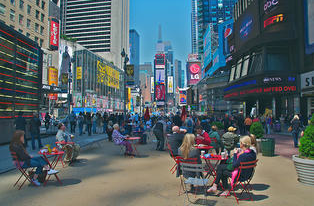One of Times Square's no-car pedestrian plazas.
The Honolulu rail project is expected to reduce the number of vehicles on our streets and highways by about 18 percent when 30,000 drivers switch to daily train travel. Fewer cars will translate to less air pollution on those thoroughfares, and that’s why the above headline at the “grist” website (motto: “a beacon in the smog”) caught our attention. Cars are banned in parts of New York’s Times Square where pedestrian plazas have been in place since 2009. The result is dramatically reduced pollution levels–63 percent less nitrogen oxide and 41 percent less nitrogen dioxide. This chart shows the Times Square air sampling for nitrogen oxide on the green line, before the plaza conversion (gray area) and after. Mayor Blumberg’s office issued a press release with the details.
Here at home, fewer internal combustion cars on the road after the rail system is operational will mean fewer movable pollution sources on our streets and highways. The rail system is expected to reduce regional pollutant emissions between 3.9 and 4.8 percent – less pollution out there for you and your family to breathe.
The project will reduce Oahu’s daily transportation energy demand by 3 percent. Hawaii imports the vast majority of the energy we consume, so reducing energy demand is an ongoing goal. Honolulu rail will help achieve it.


No comments:
Post a Comment